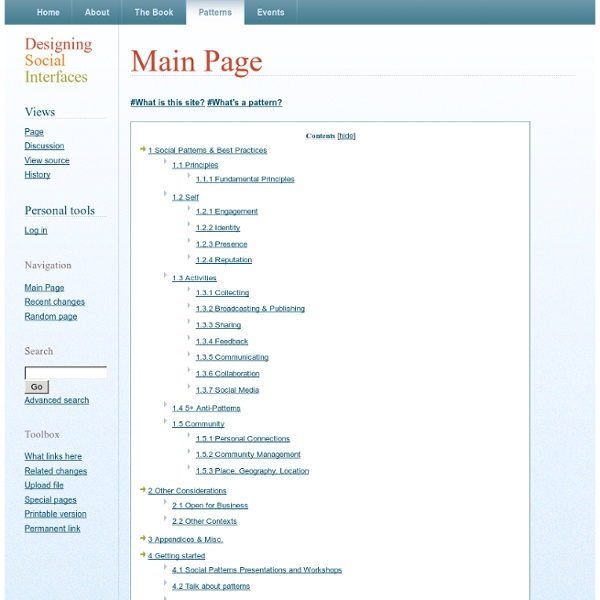



Interaction Design Pattern Library - Welie.com Suggest a pattern Have you seen new examples of patterns out there that have not been described on this site? Send me a link to an example and I'll add it to my to-do list. Suggest a pattern Latest comments Form (Lucas Gwadana) Sometimes the ERROR handling is not explicit enough because when a user makes an... Map Navigator (Marcus) For print pages etc static maps are still relevant. Accordion (dellmre) Ajax accordion samples with source code Autocomplete (Zorg) I believe the name of this pattern to be misleading. Slideshow (Joshua) Slideshows on Homepages can be very beneficial.
Yahoo Design Pattern Library We, Yahoo, are part of the Yahoo family of brands The sites and apps that we own and operate, including Yahoo and AOL, and our digital advertising service, Yahoo Advertising.Yahoo family of brands. When you use our sites and apps, we use Cookies Cookies (including similar technologies such as web storage) allow the operators of websites and apps to store and read information from your device. provide our sites and apps to you authenticate users, apply security measures, and prevent spam and abuse, and measure your use of our sites and apps If you click 'Accept all', we and our partners, including 237 who are part of the IAB Transparency & Consent Framework, will also store and/or access information on a device (in other words, use cookies) and use precise geolocation data and other personal data such as IP address and browsing and search data, for personalised advertising and content, advertising and content measurement, and audience research and services development.
Free Computer, Programming, Mathematics, Technical Books, Lecture Notes and Tutorials lovely ui Social Design Strategy Great products and services depend on their users having great experiences. But it’s not about what users do or how they do it, but rather why. Why they do what they do, why they keep coming back, and why they tell their friends. And social design aims to explain the why behind great experiences. I’ll tell you a quick story. Strand Book Store in NYC is apparently very famous, but I had never heard of it (and I’m from the New York area, too) until earlier this year when I was walking around with a friend and she pointed it out to me. That story in and of itself is not a big deal. In these cases and when we are faced with more subjective questions such as, “Where’s a good Italian restaurant?” Communities are very useful. And though we have all kinds of relationships in our lives—with coworkers, neighbors, or brands, and long lasting or short lived, formal or intimate—it’s with our strongest ties that our trust lies. Trust is built through this conversation. Building Conversation Listening
Free Programming Books Here is an uncategorized list of online programming books available for free download. The books cover all major programming languages: Ada, Assembly, Basic, C, C#, C++, CGI, JavaScript, Perl, Delphi, Pascal, Haskell, Java, Lisp, PHP, Prolog, Python, Ruby, as well as some other languages, game programming, and software engineering. The books are in various formats for online reading or downloading. This list will be updated daily. Scroll downn, or use the shortcuts below.
Design patterns, des librairies pour la conception d’interface Les sont des schémas de conception, c'est-à-dire des modèles d'interface répondant à des cas typiques d'interaction. Les design patterns permettent d'avancer rapidement lors de la conception en fournissant des gabarits qu'il suffit d'adapter et d'assembler pour construire l'interface. Notre dernière liste de librairies et sa mise à jour commençaient à dater un peu, voici une nouvelle mise à jour plus complète. Au menu de cet article : des librairies de patterns pour trouver des solutions ergonomiques ( ici ), des galeries de patterns pour s'inspirer ( ici ), et des librairies interactives pour se faire une idée ( ici ). Les librairies de patterns Les librairies ont l'avantage non seulement de proposer de nombreux patterns, mais surtout d'en expliquer l'usage. Les nouvelles librairies Des patterns actuels, avec une explication sur leur usage en contexte. Une librairie qui mérite de s'enrichir, car ses patterns sont tous actuels. Les librairies incontournables Le site est très riche. Note :
4 forgotten principles of usability testing Over the last few months I've sat through dozens of usability tests run by design agencies. Clients have asked me to oversee the tests to make sure that the agency really puts their design through its paces. This is a good thing as it shows that usability testing is now becoming a mainstream activity in the design community. But many of the usability tests I've sat through have been so poorly designed that it's difficult to draw any meaningful conclusions from them. No wonder that Fast Company mistakenly believe that user centred design doesn't work. Picture a usability test If I ask you to picture one of these usability tests, you'll probably conjure an image of a participant behind a one-way mirror, with video cameras and screen recording software. Here are 4 principles of usability testing that have been absent in many of the tests I've observed. Screen for behaviours not demographics Test the red routes Focus on what people do, not what they say Don't ask users to redesign the interface